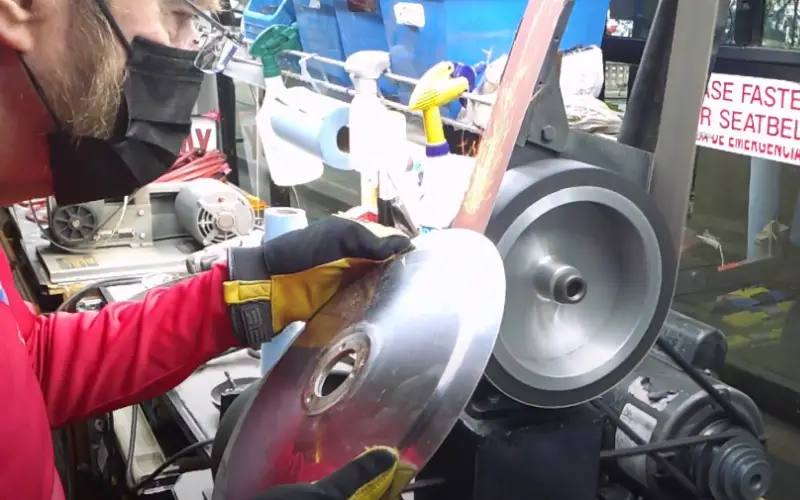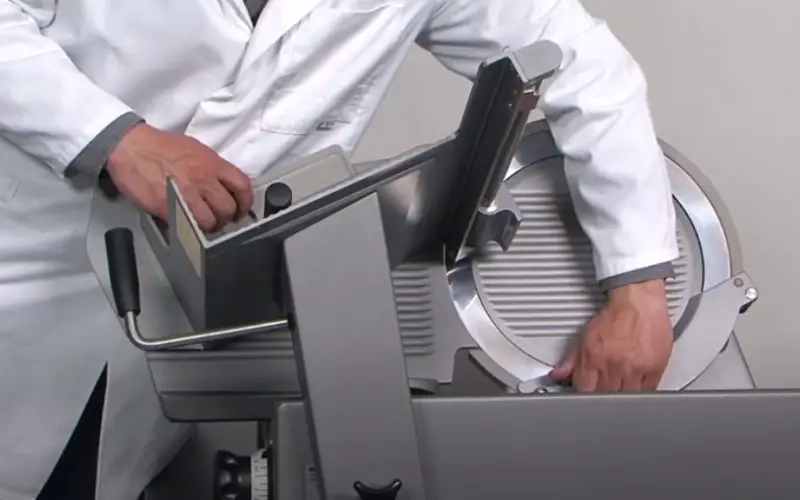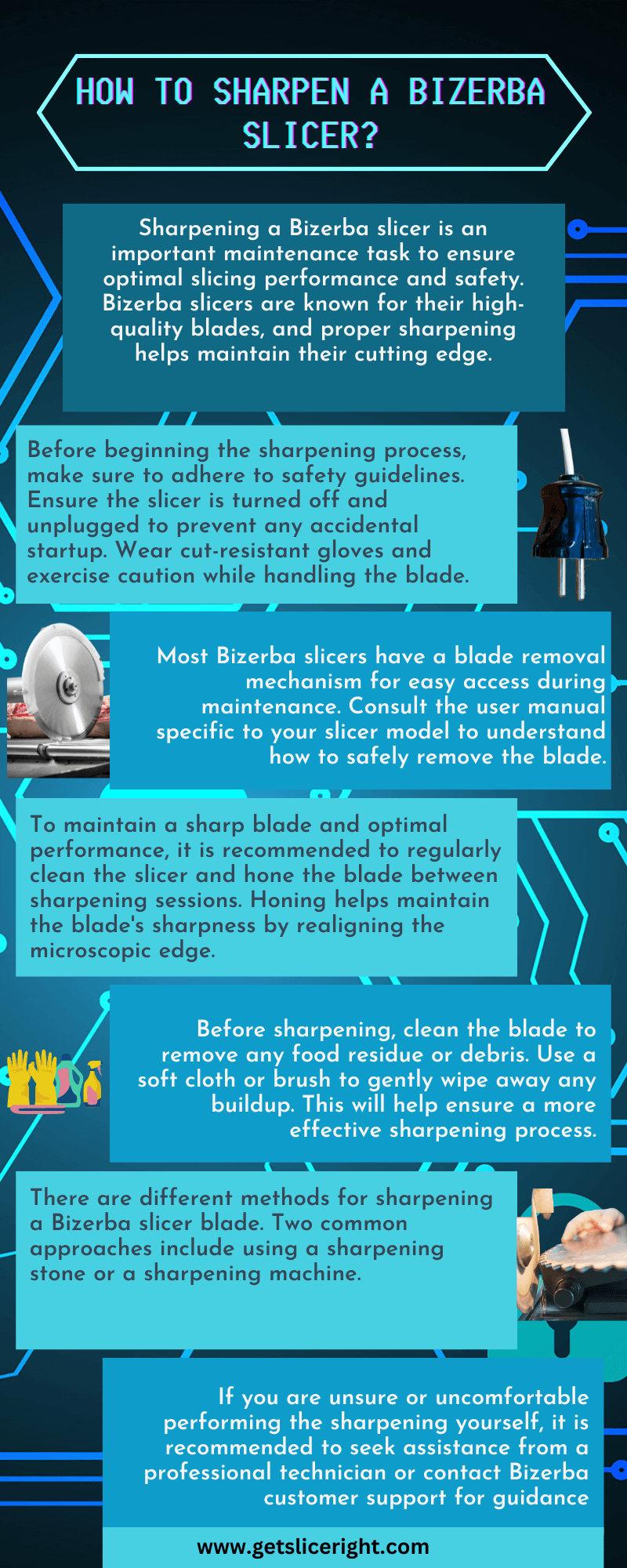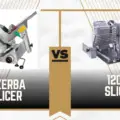A Bizerba slicer is a high-quality piece of kitchen equipment often used in commercial settings to slice meats and other food products precisely. Like any blade, with consistent use, it can become dull over time, reducing efficiency and potentially creating safety hazards. Sharpening a Bizerba slicer requires a sharpening stone to ensure it is done correctly without damaging the blade or the machine. Properly maintaining your slicer can extend its lifespan, keep it operating smoothly, and ensure consistent, clean slices every time.
How To Sharpen A Bizerba/Commercial Meat Slicer Without An Attached Sharpener?

You can use a handheld sharpening stone or steel to sharpen a Bizerba or commercial meat slicer without an attached sharpener. Always prioritize safety and follow the proper technique to avoid damaging the blade or injuring yourself.
Preparing The Slicer For Manual Sharpening
Before you begin, make sure you have the necessary equipment and follow these steps:
Step 1: Turn off and unplug the slicer.
Step 2: Clean the slicer thoroughly to remove any debris.
Step 3: Wear cut-resistant gloves for added protection.
Sharpening With A Handheld Sharpening Stone
A handheld sharpening stone, also known as a whetstone, is a versatile and widely-used tool for manual blade sharpening. Follow these steps:
Step 1: Choose a sharpening stone with the appropriate grit size. Coarser grits are suitable for dull blades, while finer grits are best for maintaining sharpness.
Step 2: Wet the stone with water or honing oil, as the manufacturer recommends.
Step 3: Hold the sharpening stone at the correct angle against the blade, usually between 15 to 20 degrees.
Step 4: Using moderate pressure, move the stone along the blade’s edge sweepingly, maintaining the angle.
Step 5: Repeat the process on both sides of the blade until the desired sharpness is achieved.
Sharpening With A Sharpening Steel
Sharpening steel, also known as a honing rod, can help maintain the sharpness of your slicer blade. Follow these steps:
Step 1: Hold the sharpening steel vertically in your non-dominant hand, with the tip on a stable surface.
Step 2: With your dominant hand, grasp the slicer blade by its handle.
Step 3: Hold the blade at a 15 to 20-degree angle against the sharpening steel.
Step 4: Starting at the base of the blade, wipe it down and across the steel in a sweeping motion, ensuring that the entire blade makes contact.
Step 5: Repeat the process on both sides of the blade, alternating between them for precise sharpening.
Maintaining Your Bizerba Slicer
Proper maintenance is essential for ensuring the longevity and performance of your Bizerba slicer. In addition to sharpening the blade, follow these tips to keep your slicer in top condition:
- Clean the slicer daily: Make sure to clean your slicer thoroughly after each use. Remove any food particles and debris to prevent bacterial growth and maintain hygiene.
- Lubricate moving parts: Regularly lubricate the slicer’s moving parts according to the manufacturer’s recommendations. This will help reduce friction, prevent wear and tear, and ensure smooth operation.
- Inspect for damage: Inspect your slicer for any signs of damage or wear. If you notice any issues, address them promptly to prevent further complications.
- Schedule professional maintenance: Arrange for professional maintenance and servicing as the manufacturer recommends. This will help identify and resolve potential issues before they become costly problems.
Choosing The Right Sharpening Stone
While your Bizerba slicer comes with a specific sharpening stone attachment, it’s essential to know what to look for if you ever need a replacement. Here are some factors to consider:
- Compatibility: Ensure that the sharpening stone is designed with Bizerba slicers. Using an incompatible stone may damage your slicer or result in uneven sharpening.
- Grit size: Choose a sharpening stone with the appropriate grit size for your needs. A coarser grit is suitable for sharpening dull blades, while a finer grit is ideal for maintaining an already sharp blade.
- Material: High-quality sharpening stones are made from aluminum oxide, silicon carbide, or diamond. These materials provide excellent durability and sharpening performance.
Troubleshooting Common Issues
If you encounter any problems while sharpening your Bizerba slicer, consider the following troubleshooting tips:
- Uneven sharpening: Double-check that the sharpening stone attachment is correctly aligned and secure if the blade is sharpened unevenly. If the issue persists, consider replacing the sharpening stone.
- Blade not sharpening: If the blade doesn’t seem to be getting sharper, ensure that you use the correct settings (A1 and A2) and allow enough time for sharpening. If necessary, replace the sharpening stone.
- Excessive noise or sparks: Excessive noise or sparks during sharpening may indicate an issue with the sharpening stone or slicer. Inspect both for damage and address any problems promptly.
FAQs
Can I sharpen my Bizerba slicer without the sharpening stone attachment?

No, using the sharpening stone attachment specifically designed for Bizerba slicers is essential.
Can I use a different type of cardboard for removing burrs?
Using the cardboard provided with your cleaning and sharpening kit is best, but any clean, sturdy cardboard should work in a pinch.
Is it safe to touch the blade while cleaning the slicer?
Be extremely cautious when handling the blade, and always turn off the slicer before cleaning.
Can I sharpen my Bizerba/commercial meat slicer blade with a knife sharpener?
A knife sharpener for a meat slicer blade is not recommended, as it may not provide the appropriate angle or sharpening method required for the blade’s unique design.
How often should I sharpen my Bizerba/commercial meat slicer blade?
Sharpening your slicer blade once a week is generally recommended. However, this may vary depending on usage and the blade’s condition.
Can I use a sharpening steel to sharpen a dull blade?
A sharpening steel is best for maintaining an already sharp blade. If your blade is very dull, using a handheld sharpening stone with a coarser grit is recommended to restore the edge before using a sharpening steel.
Conclusion

By following guidelines and maintaining your Bizerba slicer regularly, you’ll enjoy the consistent performance and high-quality slices for years to come. Always prioritize safety and cleanliness, and don’t hesitate to consult the manufacturer or a professional if you encounter any issues.
Summary:
- Gather the necessary equipment: sharpening stone attachment, brush, cleaning towel, and cardboard.
- Prepare the slicer by cleaning and attaching the sharpening stone.
- Sharpen the blade on A1 for 10 seconds and A2 for 5 seconds.
- Clean the blade and guard thoroughly after sharpening.
- Remove any burrs with a piece of cardboard.
- Sharpen your Bizerba slicer once a week for optimal performance.
- Turn off and unplug the slicer before sharpening.
- Use a handheld sharpening stone or sharpening steel for manual sharpening.
- Maintain the appropriate angle and follow the proper technique for each sharpening tool.
- Always prioritize safety by wearing a cut.

Mario Batali is a renowned author, food enthusiast, and passionate chef who has dedicated his life to exploring the world of culinary arts. With a love for sharing his knowledge and experiences, Mario has become a prominent figure in the food blogging community, inspiring countless readers with his creativity and expertise.
In addition to his culinary prowess, Mario Batali is also a talented writer with a flair for engaging storytelling. He launched his own food blog to share his recipes, cooking tips, and personal experiences in the kitchen. Over time, Mario’s blog gained a loyal following of food enthusiasts who appreciate his unique approach to cooking and his dedication to using only the finest ingredients.
Mario Batali’s passion for food and his commitment to sharing his knowledge with others have made him a true inspiration in the world of culinary arts. Through his blog, cookbooks, and public appearances, Mario continues to spread his love of food and the joy of cooking with his ever-growing fanbase.






